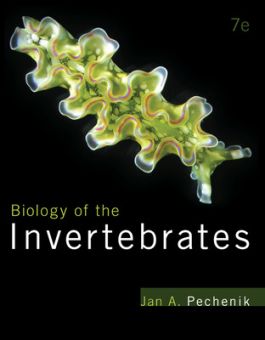Biology of the Invertebrates
7th Edition
0073524182
·
9780073524184
© 2015 | Published: February 11, 2014
This textbook is the most concise and readable invertebrates book in terms of detail and pedagogy (other texts do not offer boxed readings, a second color, end of chapter questions, or pronunciation guides). All phyla of invertebrates are covered (co…
Read More
1 Introduction and Environmental Considerations 2 Invertebrate Classification and Relationships 3 The Protists 4 The Poriferans and Placozoans 5 Introduction to the Hydrostatic Skeleton 6 The Cnidarians 7 The Ctenophores 8 The Platyhelminthes 9 The Mesozoand: Possible Flatworm Relatives10 The Gnathifera: Rotifers, Acanthocephalans, and Two Smaller Groups11 The Nemertines 12 The Molluscs 13 The Annelids 14 The Arthropods 15 Two Phyla of Likely Arthropod Relatives: Tardigrades and Onychophorans 16 The Nematodes 17 Four Phyla of Likely Nematode Relatives: Nematomorpha, Priapulida, Kinorhyncha, and Loricifera 18 Three Phyla of Uncertain Affiliation: Gastrotricha, Chaetognatha, and Cyliophora 19 The Lophophorates (Phoronids, Brachiopods, Bryozoans) and Entoprocts 20 The Echinoderms 21 The Hemichordates 22 The Xenoturbellids: Deuterostomes at Last? 23 The Nonvertebrate Chordates 24 Invertebrate Reproduction and Development--An Overview
3 The Protists 4 The Poriferans and Placozoans 5 Introduction to the Hydrostatic Skeleton 6 The Cnidarians 7 The Ctenophores 8 The Platyhelminthes 9 The Mesozoand: Possible Flatworm Relatives10 The Gnathifera: Rotifers, Acanthocephalans, and Two Smaller Groups11 The Nemertines 12 The Molluscs 13 The Annelids 14 The Arthropods 15 Two Phyla of Likely Arthropod Relatives: Tardigrades and Onychophorans 16 The Nematodes 17 Four Phyla of Likely Nematode Relatives: Nematomorpha, Priapulida, Kinorhyncha, and Loricifera 18 Three Phyla of Uncertain Affiliation: Gastrotricha, Chaetognatha, and Cyliophora 19 The Lophophorates (Phoronids, Brachiopods, Bryozoans) and Entoprocts 20 The Echinoderms 21 The Hemichordates 22 The Xenoturbellids: Deuterostomes at Last? 23 The Nonvertebrate Chordates 24 Invertebrate Reproduction and Development--An Overview
5 Introduction to the Hydrostatic Skeleton 6 The Cnidarians 7 The Ctenophores 8 The Platyhelminthes 9 The Mesozoand: Possible Flatworm Relatives10 The Gnathifera: Rotifers, Acanthocephalans, and Two Smaller Groups11 The Nemertines 12 The Molluscs 13 The Annelids 14 The Arthropods 15 Two Phyla of Likely Arthropod Relatives: Tardigrades and Onychophorans 16 The Nematodes 17 Four Phyla of Likely Nematode Relatives: Nematomorpha, Priapulida, Kinorhyncha, and Loricifera 18 Three Phyla of Uncertain Affiliation: Gastrotricha, Chaetognatha, and Cyliophora 19 The Lophophorates (Phoronids, Brachiopods, Bryozoans) and Entoprocts 20 The Echinoderms 21 The Hemichordates 22 The Xenoturbellids: Deuterostomes at Last? 23 The Nonvertebrate Chordates 24 Invertebrate Reproduction and Development--An Overview
7 The Ctenophores 8 The Platyhelminthes 9 The Mesozoand: Possible Flatworm Relatives10 The Gnathifera: Rotifers, Acanthocephalans, and Two Smaller Groups11 The Nemertines 12 The Molluscs 13 The Annelids 14 The Arthropods 15 Two Phyla of Likely Arthropod Relatives: Tardigrades and Onychophorans 16 The Nematodes 17 Four Phyla of Likely Nematode Relatives: Nematomorpha, Priapulida, Kinorhyncha, and Loricifera 18 Three Phyla of Uncertain Affiliation: Gastrotricha, Chaetognatha, and Cyliophora 19 The Lophophorates (Phoronids, Brachiopods, Bryozoans) and Entoprocts 20 The Echinoderms 21 The Hemichordates 22 The Xenoturbellids: Deuterostomes at Last? 23 The Nonvertebrate Chordates 24 Invertebrate Reproduction and Development--An Overview
9 The Mesozoand: Possible Flatworm Relatives10 The Gnathifera: Rotifers, Acanthocephalans, and Two Smaller Groups11 The Nemertines 12 The Molluscs 13 The Annelids 14 The Arthropods 15 Two Phyla of Likely Arthropod Relatives: Tardigrades and Onychophorans 16 The Nematodes 17 Four Phyla of Likely Nematode Relatives: Nematomorpha, Priapulida, Kinorhyncha, and Loricifera 18 Three Phyla of Uncertain Affiliation: Gastrotricha, Chaetognatha, and Cyliophora 19 The Lophophorates (Phoronids, Brachiopods, Bryozoans) and Entoprocts 20 The Echinoderms 21 The Hemichordates 22 The Xenoturbellids: Deuterostomes at Last? 23 The Nonvertebrate Chordates 24 Invertebrate Reproduction and Development--An Overview
11 The Nemertines 12 The Molluscs 13 The Annelids 14 The Arthropods 15 Two Phyla of Likely Arthropod Relatives: Tardigrades and Onychophorans 16 The Nematodes 17 Four Phyla of Likely Nematode Relatives: Nematomorpha, Priapulida, Kinorhyncha, and Loricifera 18 Three Phyla of Uncertain Affiliation: Gastrotricha, Chaetognatha, and Cyliophora 19 The Lophophorates (Phoronids, Brachiopods, Bryozoans) and Entoprocts 20 The Echinoderms 21 The Hemichordates 22 The Xenoturbellids: Deuterostomes at Last? 23 The Nonvertebrate Chordates 24 Invertebrate Reproduction and Development--An Overview
13 The Annelids 14 The Arthropods 15 Two Phyla of Likely Arthropod Relatives: Tardigrades and Onychophorans 16 The Nematodes 17 Four Phyla of Likely Nematode Relatives: Nematomorpha, Priapulida, Kinorhyncha, and Loricifera 18 Three Phyla of Uncertain Affiliation: Gastrotricha, Chaetognatha, and Cyliophora 19 The Lophophorates (Phoronids, Brachiopods, Bryozoans) and Entoprocts 20 The Echinoderms 21 The Hemichordates 22 The Xenoturbellids: Deuterostomes at Last? 23 The Nonvertebrate Chordates 24 Invertebrate Reproduction and Development--An Overview
15 Two Phyla of Likely Arthropod Relatives: Tardigrades and Onychophorans 16 The Nematodes 17 Four Phyla of Likely Nematode Relatives: Nematomorpha, Priapulida, Kinorhyncha, and Loricifera 18 Three Phyla of Uncertain Affiliation: Gastrotricha, Chaetognatha, and Cyliophora 19 The Lophophorates (Phoronids, Brachiopods, Bryozoans) and Entoprocts 20 The Echinoderms 21 The Hemichordates 22 The Xenoturbellids: Deuterostomes at Last? 23 The Nonvertebrate Chordates 24 Invertebrate Reproduction and Development--An Overview
17 Four Phyla of Likely Nematode Relatives: Nematomorpha, Priapulida, Kinorhyncha, and Loricifera 18 Three Phyla of Uncertain Affiliation: Gastrotricha, Chaetognatha, and Cyliophora 19 The Lophophorates (Phoronids, Brachiopods, Bryozoans) and Entoprocts 20 The Echinoderms 21 The Hemichordates 22 The Xenoturbellids: Deuterostomes at Last? 23 The Nonvertebrate Chordates 24 Invertebrate Reproduction and Development--An Overview
19 The Lophophorates (Phoronids, Brachiopods, Bryozoans) and Entoprocts 20 The Echinoderms 21 The Hemichordates 22 The Xenoturbellids: Deuterostomes at Last? 23 The Nonvertebrate Chordates 24 Invertebrate Reproduction and Development--An Overview
21 The Hemichordates 22 The Xenoturbellids: Deuterostomes at Last? 23 The Nonvertebrate Chordates 24 Invertebrate Reproduction and Development--An Overview
23 The Nonvertebrate Chordates 24 Invertebrate Reproduction and Development--An Overview
This textbook is the most concise and readable invertebrates book in terms of detail and pedagogy (other texts do not offer boxed readings, a second color, end of chapter questions, or pronunciation guides). All phyla of invertebrates are covered (comprehensive) with an emphasis on unifying characteristics of each group.

